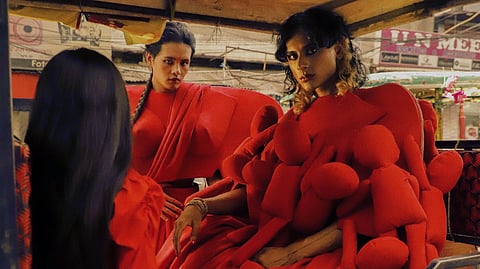
- HOMEGROWN WORLD
- #HGCREATORS
- #HGEXPLORE
- #HGVOICES
- #HGSHOP
- CAREERS
- ABOUT US
- CONTACT US

A society with conflicting ideals often struggles to accommodate an alternate existence that does not easily fit into simplistic ideas governed by class, caste and gender. This is best exemplified in the mistreatment of intersex individuals who struggle to find basic dignity within Indian society. Historically known as ‘Hijra’ within South Asian culture, these individuals often pay the price for being born with an anatomy that doesn't conform to rigid binaries.
This discriminatory behaviour seems more absurd when one learns of the rich history of reverence towards intersex people within ancient mythology and scriptures. The community finds mention in everything including the epic tale of Ramayana and are often welcomed to grace any auspicious celebration. They dance at temples, sing ballads at the birth of a newborn, and bestow marriages with their presence, due to the shared belief that they have the power to bless or curse.
However this reverence does not translate into providing them with the very basic human rights of life and dignity. Many of these individuals are often caught up in sex trafficking due to a lack of infrastructure that could keep them safe from harm. They often spend an entire lifetime begging outside car windows, with many companies refusing to employ them. This translates to a conflicting existence, as to most Indians, they remain figures of both mystique and sheer disdain.
Even the term ‘Hijra’ has been weaponized against the community and often used as a slur. Highlighting the experience of living in an intersex body, a new photoseries, 'Hijra Gali Nahi Hai', intends to vocalise the inner turmoil of the community, and their yearning to be accepted for their womanhood and not be merely seen as either a fetishised figure or to be mocked. One on one interviews provided space for the community to share their experiences on the street, where they are mostly misunderstood and frequently become victims of misbehaviour.
The photo series and costuming showcases these experiences and exhibits the raw struggle that they must go through to attain a valid existence and acceptance in the roles of their choosing. The colour red used in the series is often associated with goddesses and is considered auspicious in India. The series contrasts their presence with others in the market who often tend to alienate these individuals and restrict them from entering mainstream spaces, hence highlighting the paradoxical nature of their place within Indian society.
Designer - Supriti Mukherjee
Design Mentor - Mehendi Sharma, Abhishek Chauhan
Styling and Art Direction - Sneha Rameshkumar
Assistants - Dheeraj Ningombam, Rachi Chitkara
Photographer - Aditiya Mittal
Makeup - Siya Garg
Models - Ojas Tyagi, Aman Gurung, Trisha
Hair - Siya Garg
If you enjoyed reading this, here's more from Homegrown:
Tikam Chand & His 150-Year-Old Camera Are Preserving The Art Of Vintage Photography
Vrinda Maheshwari's Photoseries Highlights An Emotional Journey Of Trauma & Survival
Rural, Raw, & Rooted: A Homegrown Photoseries Captures The Beauty Of Imperfections
